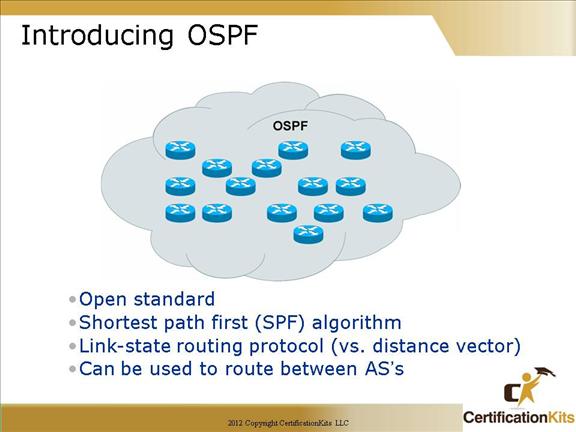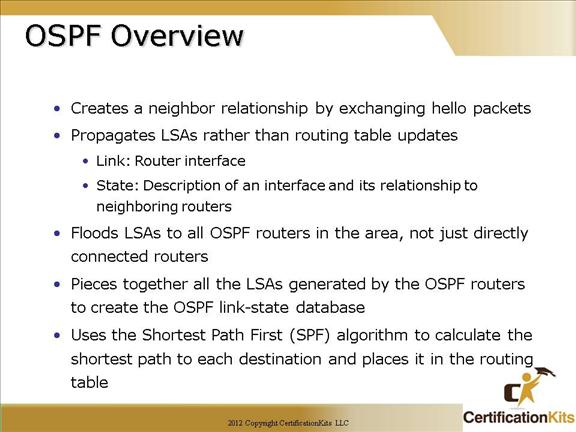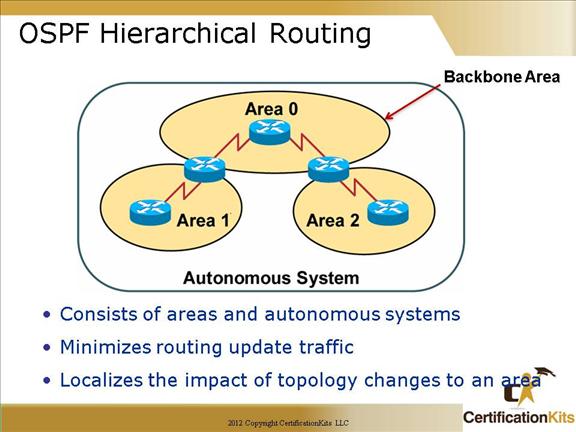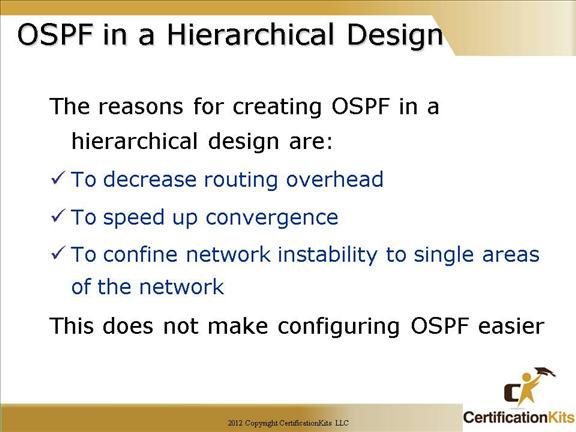Cisco CCNA Introducing OSPF

Unlike EIGRP which is Cisco proprietary, Open Shortest Path First (OSPF) is an open standards routing protocol that’s been implemented by a wide variety of network vendors, including Cisco. If you have multiple routers, and not all of them are Cisco (what!) then you can’t use EIGRP now can you? So your remaining options are basically RIP, RIPv2, OSPF or IS-IS. If it’s a large network, then really, your only options are OSPF and IS-IS, or something called route redistribution—a translation service between routing protocols.
OSPF converges quickly, although perhaps not as quickly as EIGRP, and it supports multiple, equal-cost routes to the same destination. But unlike EIGRP, it only supports IP routing. As OSPF is a link state routing protocol, it can be CPU intensive.
Cisco CCNA OSPF Overview

The Open Shortest Path First (OSPF) protocol, defined in RFC 2328, is an Interior Gateway Protocol used to distribute routing information within a single Autonomous System. The OSPF protocol is based on link-state technology, which is a departure from the Bellman-Ford vector based algorithms used in traditional distance vector routing protocols such as RIP. OSPF has introduced new concepts such as authentication of routing updates, Variable Length Subnet Masks (VLSM), route summarization, and so forth. A router running OSPF sends link state advertisement (LSA) packets ever 30 seconds to advertise its state as well as immediately when the state changes. OSPF routers utilize the Shortest Path Algorithm (SPF) to calculate the shortest path to each node.
Cisco CCNA Hierarchical Routing

OSPF is designed in a hierarchical fashion, which basically means that you can separate the larger internetwork into smaller internetworks called areas. All OSPF networks MUST contain Area 0 and all areas MUST directly connect to Area 0. This is depicted in the slide where both Area 1 and Area 2 are directly connected to the Backbone Area, Area 0. There is one exception to this rule where a virtual link can be established but it should only be used for a temporary solution (i.e. merging two different company networks). Details of virtual links are not covered in this course.
Cisco CCNA OSPF in a Hierarchical Design

OSPF has special restrictions when multiple areas are involved. If more than one area is configured, one of these areas has be to be area 0. This is called the backbone. When designing networks it is good practice to start with area 0 and then expand into other areas later on.
The backbone has to be at the center of all other areas, i.e. all areas have to be physically connected to the backbone. The reasoning behind this is that OSPF expects all areas to inject routing information into the backbone and in turn the backbone will disseminate that information into other areas.
Utilizing multiple areas is typically a good design for OSPF. Creating OSPF in a hierarchical design has numerous benefits that include:
– Decreasing routing overhead
– Speeding up convergence
– Confines network instability to single areas of the network
Note: While it makes OSPF more efficient, it does not make configuring OSPF easier.
If you remember, we discussed link state routing protocols and identified that they require more administration. This design administration requires that all OSFP routers are configured in a hierarchical area design.
RIP & IGRP use the Bellman-Ford algorithm to find their best route, OSPF uses the Dijkstra algorithm to find the shortest path to remote networks.
OSPF uses protocol value 89 in the IP packet.
OSPF communicates through the use of multicast packets.
All OSPF routers participate in multicast group 224.0.0.5
All OSPF designated routers (DR & BDR) participate in 224.0.0.5 as well as 224.0.0.6
OSPF was developed to combat the limitation of RIP.
OSPF is a LINK STATE Routing protocol that has these following characteristics:
Speed of convergence
Faster than RIP with minimum of traffic exchanged
VLSM
Supports summarization at area boarders
Reachability
No hop count limits, approx 40-50 routers per area
Bandwidth Utilization
Incremental updates, topology data kept within single area
Path selection
Metric based on bandwidth, equal cost load balancing over up to six paths
Area 0 is called the backbone area
You must have an area 0
Multiple OSPF areas must connect to area 0
Hierarchical OSPF networks do not require multiple areas
OSPF is standards based so it can inter-operate with routers from other vendors
Process ID’s can be assigned any number from 0 to 65535. Unlike an Autonomous System (AS) in EIGRP, Process ID’s can be different on each router and still communicate.
Area’s can be any number up to 2.4 billion and can even be displayed as an IP address if you wish.
OSPF is designed in a hierarchical fashion, which basically means that you can separate the larger internetwork into smaller internetworks called areas. All OSPF networks MUST contain Area 0 and all areas MUST directly connect to Area 0. This is depicted in the slide where both Area 1 and Area 2 are directly connected to the Backbone Area, Area 0. There is one exception to this rule where a virtual link can be established but it should only be used for a temporary solution (i.e. merging two different company networks). Details of virtual links are not covered in this course.
OSPF has special restrictions when multiple areas are involved. If more than one area is configured, one of these areas has be to be area 0. This is called the backbone. When designing networks it is good practice to start with area 0 and then expand into other areas later on.
The backbone has to be at the center of all other areas, i.e. all areas have to be physically connected to the backbone. The reasoning behind this is that OSPF expects all areas to inject routing information into the backbone and in turn the backbone will disseminate that information into other areas.
Utilizing multiple areas is typically a good design for OSPF. Creating OSPF in a hierarchical design has numerous benefits that include:
– Decreasing routing overhead
– Speeding up convergence
– Confines network instability to single areas of the network
Note: While it makes OSPF more efficient, it does not make configuring OSPF easier.
- •Identified by a 32 bit field
- • Manually configured
- • If only one area exists, it’s ID can be ANY number
- • If more than one area is defined, area 0 must exist and is the backbone
- • Area 0 must be connected to all other areas
- • There is only one area 0






